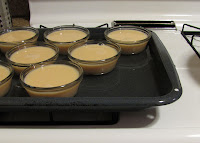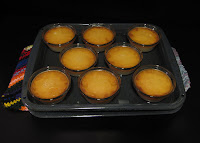
Ali nagging me for flan fired me up to give it a try. Having recently tried crème brûlée, it'd be neat to see the difference. Initially thinking I'd do a pumpkin flan, I didn't plan far enough in advance. With the pumpkin still frozen, I turned to The Border Cookbook and opted to try one of the three flan recipes found, aiming for the one that appeared most "classic".
I didn't make any adaptations to the ingredients (unless eyeballing the vanilla extract quantity counts) or to the method, though I wrote the method to reflect what I did specifically. I like to minimize my movements and streamline things a bit.
Rancho De Chimayo Flan
adapted from The Border Cookbook and found here, though slightly different than the book
click to print
2 1/4 c evaporated milk
1 3/4 c sugar, divided
3/4 c water
6 eggs
1 1/2 tsp vanilla extract
Preheat the oven to 300°F.
Set 8 6-oz custard cups in a baking dish or broiling pan large enough to accommodate all the cups, with a little room for air circulation, within easy reach of the stove.
To prepare the custard, combine the evaporated milk, 1 1/2 cups of sugar, water, eggs, and vanilla extract in the top of a double-boiler. Beat with a whisk for about 1 minute or until the mixture is well blended and begins to froth.


Insert the pan over its water bath and heat the mixture over medium-low heat until it is warm throughout, reducing the heat to very low, if necessary, to prevent the custard from boiling while preparing the caramel.


To prepare the caramel, place the remaining 1/4 cup of sugar in a small, heavy saucepan and cook over low heat.

Watch as the sugar melts into a golden-brown syrup. There is no need to stir unless the sugar is melting unevenly. Once a rich medium-brown, immediately remove the pan from heat.






These images were collected over 9 minutes, beginning 10 minutes after the sugar was placed on the burner.
Top row: sugar beginning to melt, melting further, and just a little bit of granules still present.
Bottom row: the pan was swirled so that I'd be better able to tell if the sugar was completely melted, sugar completely melted (and "rich medium brown" or amber), sugar removed from the burner a little too late as I had wondered if it was really done in the image before. "Rich medium brown" is too vague for me!
Pour about 1 teaspoon of caramel into the bottom of each custard cup; the poured syrup will harden almost immediately.

Don't bother trying to measure the sugar or spread it evenly in the cups. Simply work quickly pouring the sugar equally. The sugar will harden quite literally, "almost immediately". Attempts to spread the sugar will result in fine hair-like strands of hardened sugar between the cups.
To assemble the flan, pour the warmed custard mixture equally into the cups.



That orange egg chunk was removed from the custard before I began dispensing it among the cups. Rather than pour directly from the spout-less bowl and risk sloshing the custard all over the stove or get water into the custard, I used a 1/3 cup measure.
Add enough warm water to the pan to cover the bottom third of the cups.


Bake 1 hour and 45 minutes. Check to see if the custard is firm and its top has just begun to color a light brown; if not, bake for up to 10 minutes more.

Done in 1 hour and 45 minutes.
Remove the cups from the oven and let them cool for 15 to 20 minutes at room temperature. Cover the cups and refrigerate them for at least 3 hours or overnight.



Serve as is or for a nicer presentation, unmold. Just prior to serving, take the cups from the refrigerator and uncover them. Unmold by running a knife between the custard and the cup. Invert onto a serving plate. Repeat with each flan.
The recipe linked above itemizes "6 eggs, slightly beaten", and I'll do just that next time. I found that my whisk merely chased the yolks around in the pool of watery, milky, egg whites. Once pressing each yolk against the bowl with the whisk, they readily went into solution.
I don't have a double boiler (and likely never will unless my future kitchen is so cavernous that I have to fill it with unnecessary gadgetry). To accommodate such a volume of custard without allowing the bottom of the bowl to touch the water meant I had to use the pot I use to cook pasta, an 8-quart mofo. That's big. I didn't have any worry about the custard boiling, but quite the opposite: I didn't think it'd even get warm since I was extremely reserved about the heat. The timing and heat ended up working out perfectly as the custard was just warm to the touch, guessing about 110°F, when I was done dispensing with the syrup.
Making caramel or sugar syrup is so simple! I used to be afraid of this but having done it a couple times now, have no fear at all. And actually I'm now wondering whether I'd be able to spin sugar. When transferring the syrup to the cups, I used a teaspoon and tried using it to spread the cooling syrup in the bottom of the cups. As I moved from cup to saucepan, I found that fine wisps of sugar were trailing. Interesting. Oh, and it turns out while the custards bake the sugar becomes evenly dispersed across the bottom of the custard cups so there really is no point in worrying about spreading it anyway. It's sort of magical how it works.
As for the flans, I took them to work and they went over very well. Ali ate 3 or 4. I learned that I should've trusted my sugar melting judgment and took the sugar off the burner as soon as the sugar was completely melted rather than watching to see if it would turn the magical brown I was expecting. The sugar turned out a little bit bitter but was still edible.
Cost:
- evaporated milk: $1.88
- sugar: $0.37
- eggs: $1.82
- vanilla extract: $0.11
0 comments:
Post a Comment